India is a melting pot of various cultures and ethnicities. Indians take pride in their diversity and celebrate each art and craft form in the most beautiful way. In fact, art and craft are an integral part of Indian society and it is cherished in the form of festivals, handicrafts, etc.
The Madhubani Indian folk art is a tribal art form in India that finds its genesis in the Mithila region of Bihar. If we look at the Madhubani painting history, we shall see that intricate designs and patterns characterise the madhubani painting designs. The madhubani painting black and white is one of the beautiful additions when you are looking for a madhubani painting on wall.
Origin of Madhubani Paintings
“Madhubani” means forest of honey. The term itself has a natural and fresh feeling to it, and so do the paintings and artwork in this style. Madhubani painting is a prominent folk art form in India that originated in the Madhubani area of the Mithila region, Bihar. Mithila Art is another name for the artwork. Women from several Indian tribes are credited for developing this ancient art form, which was first practiced on plastered mud floors and walls of cottages. The mithila painting, however, are now done on fabric, handmade papers, and canvas. The origins of mithila art are obscure.
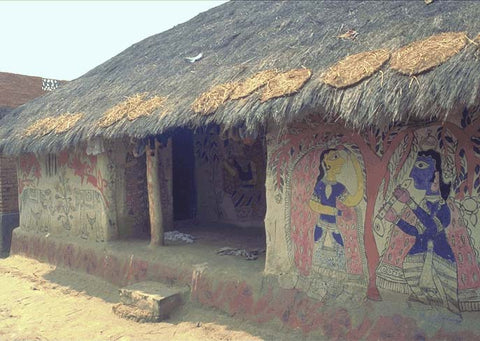
(source- Wordpress)
Mithila or Madhubani painting is a folk painting tradition that dates back to the Stone Age. However, it is thought that King Janak, monarch of the Mithila Kingdom in the 8th or 7th century BCE, ordered the painters to make these madhubani art designs to commemorate his daughter Sita's marriage to Prince Rama. Bihar's people are extremely religious due to the land's history and religious heritage. This is seen in their arts, crafts, and textiles. Madhubani painting attained national attention and press coverage in 1975 when Sita Devi was awarded the National Award and Jagdamba Devi was awarded the Padma Shri by the President of India.
Making of Madhubani Paintings
Traditionally, handmade Madhubani paintings were made using colors extracted from natural resources like flowers( Aparajita flower is used for blue, bougainvillea for pink, flat bean leaves for green, turmeric for yellow, and rice powder for white), vegetables, and mineral stones They made brushes out of bamboo sticks and twigs. But today, artisans prefer using readily available colors and brushes from the market to avoid the tedious process of extraction and painting.
Earlier, to maintain the vibrant color of the natural pigments, the paper was treated with cow dung before being painted. For sketching the black border, cow dung was mixed with charcoal and water. The artist creates the precise black outline with a bamboo stick, which cannot be wiped or modified once started. This black outline fills the whole sheet of paper. Mithila painters do not leave any blank space on their canvas. They decorate the entire place with natural elements like birds, flowers, animals, fish, snakes, the Sun, and the moon, which frequently have symbolic values such as love, pleasure, fertility, eternity, well-being, and success.
In the past, only women from lower castes performed madhubani art drawing; however, these restrictions have since been overcome. Madhubani painting is practiced by both men and women, regardless of caste, religion, or region.
Unique Madhubani Painting Styles
Mithila paintings are divided into two 'gharanas': Ranti Gharana and Jitwarpur Gharana (both located in Madhubani districts), this extraordinary art form is further divided into five distinct styles. These unique Madhubani painting styles include-
BHARNI- “Bharni” means “to fill” in Hindi. In this style, the outlines of the design are drawn in bold and dark black, and the patterns are filled with vivid colors like as red, yellow, orange, and so on. Bharni paintings often show themes of Hindu gods and goddesses.
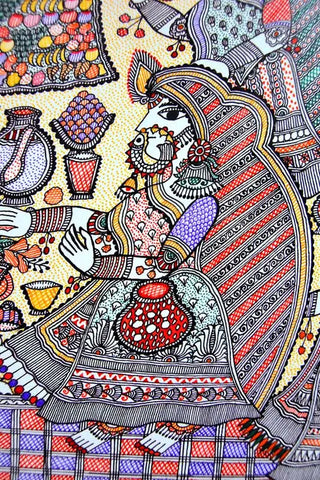
(source- D'source)
KACHNI- Kachni refers to "line art." Extensive line paintings are created in the Kachni style. The designs are filled with little dots or finely drawn parallel lines. The thickness of the lines changes according to the design. This beautiful madhubani painting technique appeals to people because it emphasizes the unique features of natural aspects like flora and fauna with a limited color palette. Mostly using a monochrome or only two colors.
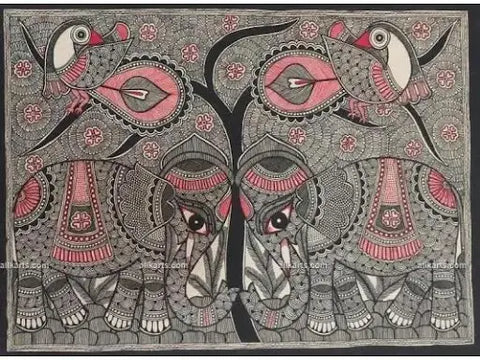
TANTRIK- Mithila or Madhubani art is a special form of painting that accurately depicts traditional and religious scriptures. The majority of Tantrik artworks reflect Tantra's influences in their painting patterns. These paintings generally feature Hindu mythical figures, in whom the Hindu community has a deep belief. People in India keep these paintings in their homes or use them for festival prayers and ceremonies.

(source- pinterest)
GODNA- The discovery of Godna Madhubani artwork is considered to have been done by Chanu Devi, who used bamboo and kajal pen to create the masterpiece. This painting represents natural creatures such as wildlife, the tree of life, and florals. Godna Painting is an ancient Indian tattooing style. Modernization has had a significant impact on Godna art and artists. Tattooing has moved away from the body and onto paper, fabric, and canvas. Female tattoo artists have played an essential role in the spread of Godna painting throughout the country.
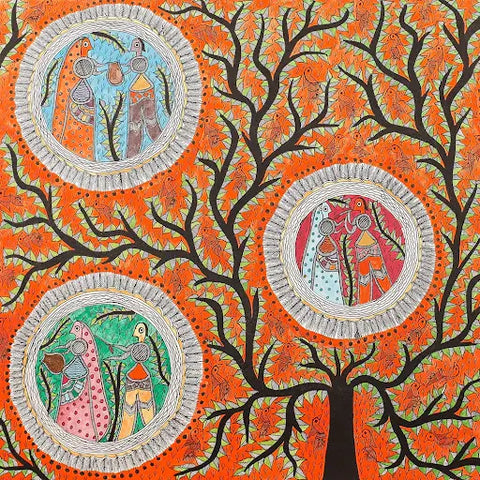
KOHBAR- Kobar is a highly valued term in Madhubani art since it is associated with a Hindu wedding ritual. Tantra Raj, Yog Yogini, and Shiv Shakti are other names for Kobar art, which symbolizes strength with Lord Shiva's blessing. This painting typically represents Hindu wedding festivities and is done on the walls of the bride and groom's house.

(source- pinterest)
Madhubani Art for Home Decor
Madhubani art form in the form of wall murals, cushion covers, paintings etc., can be a great addition to the interior decor of your place. Home decor items such as various types of Madhubani paintings can add a dash of ethnic touch to your interior decor and enhance the vibe of your living space. You can also get Madhubani bed and table linen, decorative plates and various other products to revamp the aesthetic appeal of your home.
Wear the Art
This artistic form is far too beautiful to be restricted to paintings and artworks. It is a blessing for the traditional fashion industry to be able to incorporate Madhubani artwork. It has a uniquely elegant design and inspiration for many designers, making its presence known on the fashion catwalk. Designs inspired by Madhubani art may be readily worn to make a fashion statement. Such as Madhubani sarees, have intricately detailed patterns which can make heads turn! You can pair it with simple jewelry and a handbag.
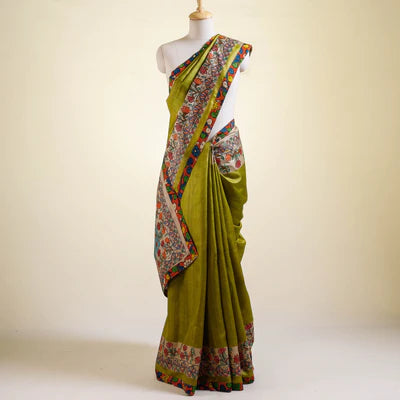
Styling a plain kurta can be difficult, so add a Madhubani dupatta over your kurta or salwar set and upgrade your ethnic look. Madhubani, as a stunning work of art, can enhance any style and create a fashion statement.
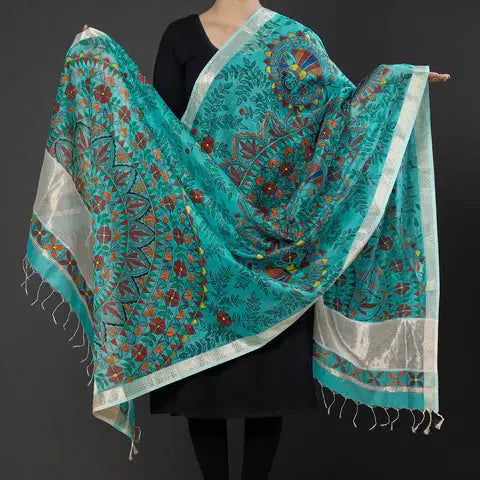
Modernization of Madhubani painting and art
Paintings and Art
As a result of modernization, some craftsmen have abandoned traditional and original crafts in favor of creating stylized modern artworks. New art forms are emerging without regard for the value of conventional art. The art's traditions have not been conserved, and new forms and subjects have emerged. Due to rising living standards and a lack of respect, very few artists are willing to continue the art. Modernization and digitization are contributing significantly to the extinction of this and many other traditional trades. As a result, it is critical to maintain this craft and protect cultural heritage. Paintings are being made which have no rhythm in the backgrounds, patterns, colors, or reflection of traditions. The subjects of the modern form of art are determined by the client, and the paintings are created by the concepts and color combinations specified by the client. Another study supported this by claiming that artists have been summoned to many places abroad for workshops, and this is how the art has spread internationally, but it has also lost its traditions.
As Indians, we should promote this beautiful art form worldwide. We should keep the art form alive and extensively work towards reviving its originality.So wait no longer to try out Madhubani products from the best handicraft store in India!Takeaway
The rich heritage of the Madhubani paintings’ history is a testament to the significant and timeless appeal of this traditional art form.
This art form is a perfect personification of the stories, myths, culture and beliefs stemming from the Mithila region. The widespread popularity of this art form signifies that its desirability has transcended not just national but international borders as well.
As Indians, we should promote this beautiful art form worldwide. We should keep the art form alive and extensively work towards reviving its originality. So wait no longer to try out Madhubani products from the best online handicraft store in India!
Frequently Asked Questions on Madhubani Paintings
-
Madhubani painting belongs to which state?
Madhubani paintings belong to the Mithila region of Bihar. This traditional art form exemplifies our rich and vibrant cultural heritage that has withstood the test of time.
-
What is special about the Madhubani painting?
The cultural significance, unique style and historical background set Madhubani paintings apart from any other art form.
-
What is the main theme of Madhubani painting?
The Madhubani Indian folk art including paintings revolves around the depiction of Hindu epics and various events of religious and cultural significance.
-
Which cloth is used for Madhubani painting?
The artisan opts for a tightly woven fabric that can withstand the intricate details of the Madhubani painting. Cotton and silk are the most preferred fabric for making Madhubani paintings.
-
What material is Madhubani art made of?
Madhubani Painting is done on different kinds of materials like canvas cloth, and handmade paper, for painting. You can get wearable Madhubani art in the form of a saree or dupatta in cotton, silk and linen.
-
How to care for clothing with Madhubani art painted?
In order to care for clothing with Madhubani art painted, it is advisable to keep the cloth away from direct sunlight and to handle it with clean hands. You should also store the cloth properly and keep it away from moisture.
Blogs you might also like
Explore the breathtaking beauty of 5 unexplored Indian heritage sites
Pichwai art: the folk art of Nathdwara, Rajasthan
Summer Fashion: 7 Pastel colour saree ideas for a comfy summer soire
 Verified Purchase
Verified Purchase






















Leave a comment (all fields required)